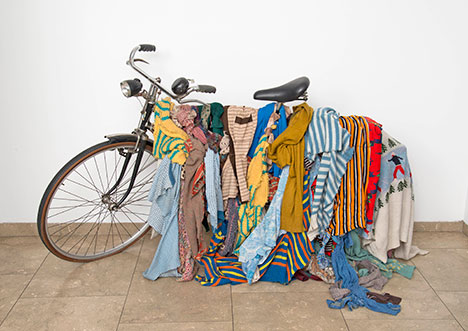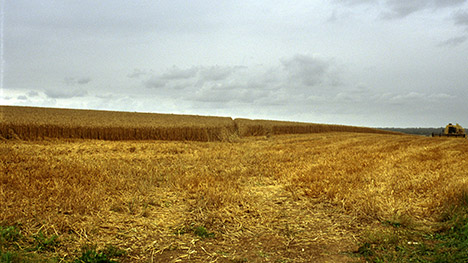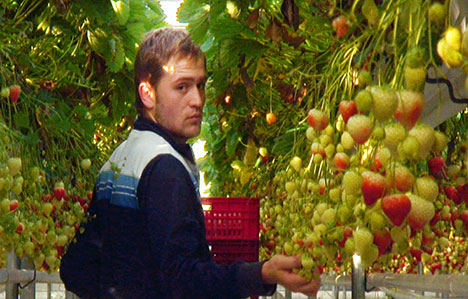Art Monthly 365
April 2013
Michelangelo Pistoletto
Interviewed by Alex Coles
Life and Death
Paul O’Kane
Identity Crisis
Maja & Reuben Fowkes
Duchamp et al
Mark Harris
Buy Now – select:
Want to read this right now?
Get instant access to the entire back catalogue via Exact Editions from only £8.99!
Contents

Michelangelo Pistoletto Peacock 1968-74
Interview
The Minus Man
Michelangelo Pistoletto interviewed by Alex Coles
A key figure within Arte Povera, Michelangelo Pistoletto is one of the most significant Italian artists of the 20th century. Now in his 80th year, he continues to present challenging projects, such as his forthcoming exhibition at the Louvre. Here he talks about his evolving studio, the difference between design and art, and the path he negotiates between disinterested theory and radical politics.
'I was always telling the students at the Viennese Academy that art is not just something you produce in order to make money, art can be used in a more thoughtful way and make a broader societal impact. It was only while at the academy that I began to develop Cittadellarte, a place that could be simultaneously independent and yet still dependent upon it. I chose the name Cittadellarte precisely because it incorporates two meanings: the citadel, where art is protected, and the city, with its openness.'

Patrick Keiller Robinson in Ruins 2010
Feature
Life and Death
Paul O'Kane on art and being
If art in secular societies plays some part in defining humanity, how have artists such as John Akomfrah, Nick Broomfield and Patrick Keiller met the challenges laid forth by globalisation's increasingly pervasive and invasive brand of technocapitalism?
'When, occasionally, the shameful excesses, inadequacies and inequalities underpinning consumerism are glimpsed in news media, these "shocking facts" become yet more fleeting images, commodified emotions of momentary indignation and injustice.'

Adam Chodzko The Pickers 2009
Feature
Identity Crisis
Maja & Reuben Fowkes on the return of the East European
When the coalition government recently proposed running an anti-UK advertising campaign in Eastern Europe with the aim of discouraging immigration, it brought an outmoded cultural categorisation back to life. Perhaps Number 10 might have looked at the work of Adam Chodzko, Roman Ondák, Dan Perjovschi and Nedko Solakov before returning the generic 'East European' to the discourse around identity.
'In the 2000s these artists were likely to feel at home in the post-identitarian circuits of a globalised art world which abandoned the cult of origins in favour of a universalist outlook, but now they are faced with the return of the East European.'
Comment
Editorial
Mallification
The ugly word 'mallification' perfectly describes the proposed redevelopment of the Southbank Centre, infilling its open spaces with glass-fronted retail outlets. Might this current Tory-led coalition, by refusing to list the building during the lifetime of its parliament, finally succeed where its Conservative predecessors failed?
'Built under a Labour government in 1968 for the then London County Council, the Southbank Centre has been perceived by successive Tory governments as an affront, a socialist bastion occupying the left bank of the river, so to speak – the People's Palace set up in opposition to the Palace of Westminster.'
Letters
Nicky Hamlyn and AL Rees object to Christopher Townsend's review of the 'Film in Space' exhibition at Camden Arts Centre in AM363.
Artnotes
Tory minister Ed Vaizey accuses the arts sector of scaremongering over government cuts but has his own interpretation called into question by those whose statistics he relied upon; the political reason for Westminster City Council's axing of its arts funding is revealed; Belfast and Norfolk councils recognise the value of the arts and buck the trend for cuts; Space Studios petitions against planning policy changes; the public art sector shrinks; independent art schools open; galleries open and close; and all the latest news on appointments, prizes and more.
Submissions: Send Artnotes info to artnotes@artmonthly.co.uk
Reviews
Exhibitions
The Bride and the Bachelors: Duchamp with Cage, Cunningham, Rauschenberg and Johns
Barbican, London
Mark Harris
Schwitters in Britain
Tate Britain, London
Morgan Quaintance
Bela Kolarova
Raven Row, London
John Douglas Millar
Xu Bing: Landscape Landscript
Ashmolean Museum, Oxford
Stephen Lee
Rosa Barba: Subject to Constant Change
Cornerhouse, Manchester
Turner Contemporary, Margate
Bob Dickinson
Carsten Nicolai: Observatory
Ibid Projects, London
Eliza Williams
Shaun Gladwell: Cycles of Radical Will
De La Warr Pavilion, Bexhill-On-Sea
Paul Carey-Kent
Hayley Newman and Emily Speed: The Practice of Space
Castlefield Gallery, Manchester
Martin Herbert
Alice Channer: Invertebrates
Hepworth Wakefield
Morgan Quaintance
London Round-up
Matt's Gallery • White Cube • Michael Werner Gallery • Carlos/Ishikawa
Chris Fite-Wassilak
Reviews
Books
Jens Hoffman: The Studio
Alex Coles: The Transdisciplinary Studio
Jennifer Thatcher on the changing role of the artists' studio
'To read the latest material on the contemporary studio, you would be forgiven for thinking that artists fall into only two camps: the 'post-studio' artists, who need only a laptop and a cafe, and those working in large, expanded studios, who prefer to think of themselves as cultural producers.'
Hito Steyerl: The wretched of the Screen
Maria Walsh on image re-production in a networked age
'Hito Steyerl is also a theorist, trained in philosophy, but these essays are clearly from the perspective of an artist reflecting on the conditions of image production and the possibilities for a politics of art in a context in which information flattens out visual content, recombining it in packages where all is reduced to the abstraction of algorithmic value.'
Report
Letter from Mexico
The Next Generation
Kathy Battista on the boom in the Mexican art scene
'Much like the yBa phenomenon, the Mexican art scene seems to be entering its autophagic stage, where, surfeited by the local, it is currently opening up to provide further context for its own artists.'
Artlaw
Site-specificity
Who Owns Street Art?
Henry Lydiate on the removal of street art from the public arena
'Museum and gallery collections, private and especially public, do not as a rule play the market. Are they likely to acquire original street murals? Assuming that curators diligently check the provenance and prove such a work's legal ownership (and right to sell, donate or bequeath), the same ethical objection recently articulated by art-market professionals may arise: site-specificity.'
Listings
Exhibitions
Exhibition listings
Art Monthly's exhibition listings can also be viewed online.










